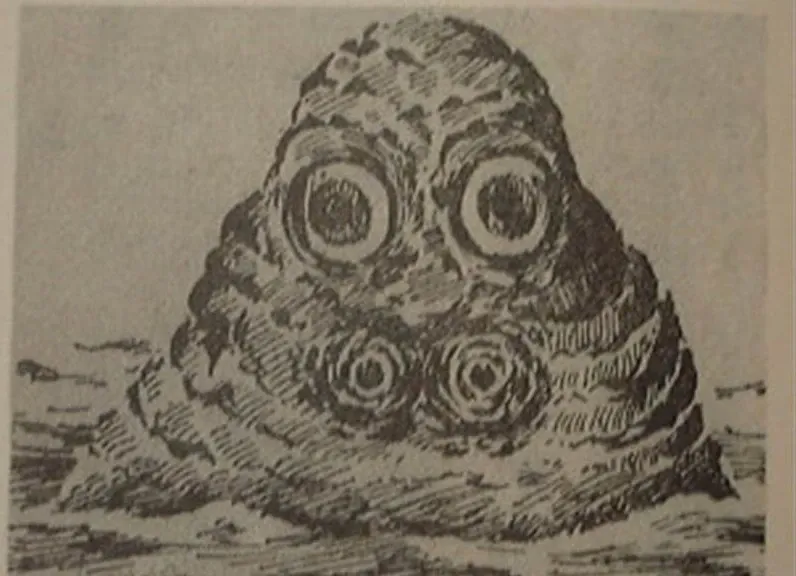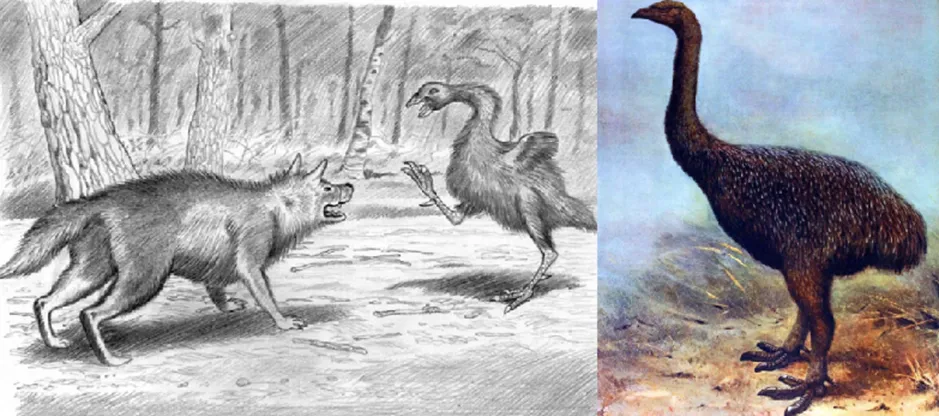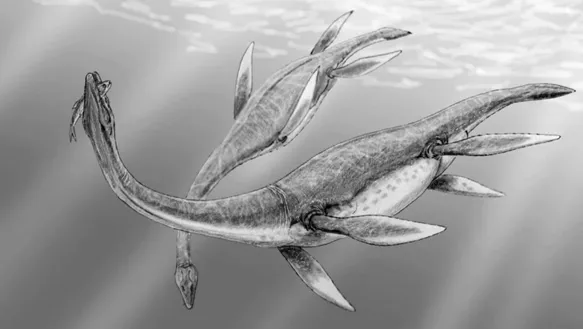Cryptids of New Zealand: Part 1
Katrina Borthwick - 25th November 2024
I’m taking a break from my post conference daze to write about something completely unserious – New Zealand Cryptids. Cryptids are animals whose existence or survival is disputed or unsubstantiated, such as the Yeti or the Loch Ness Monster.
In doing this I have completely ignored confusing lizards and regular sized birds, as they’re a bit boring. Instead, I have focused on sea monsters and giant beasts of the land. As you can imagine, being an island nation, we have a disproportionate number of the former.
Kabagon
Kabagon is described as a sea creature with big nostrils and eyes, that was seen off the coast of Lyttleton by a Japanese fishing boat 1958. Mysterious footprints were reported on a nearby beach later after the sighting. Kabagon is sometimes described as a ‘Hippo Monster’, and a drawing by the sea captain shows a head a bit like Jabba the Hutt from Star Wars.

‘Kaba’ is the Japanese word for hippopotamus. The witnesses described Kabagon as being 200 metres away with red eyes, and estimated to be 10 metres in length. However they could only see 1.5 metres of the head sticking up out of the water, and it disappeared before they could catch it.
The problem with the sea, just like the sky, is it can be a bit tricky to judge distances without a reference object. That means you can find yourself in a situation where something close and small looks far away and big. That’s how fireflies get mistaken for rapidly manoeuvring alien spaceships.
Also, due to the layering of different temperatures of air, you can end up with optical effects such as superior mirages, or fata morgana, which can make things look bigger, like they’re floating in the air or even upside-down.
You can watch a short 15-minute video about the Kabagon sighting from a kiwi perspective here:
The video also includes an interesting backdrop of the local fishing politics (and brawls), the outrage over the mistreatment of a penguin, and the similarities between Kabagon and a godzilla-fighting, pollution-eating Japanese space monster. This does raise the possibility that the Japanese were doing a bit of trolling….
However, on balance, it was most likely an elephant seal peeking out of the water, perhaps with a case of pinkeye. Male elephant seals can grow up to 4 metres long, and weigh up to 2000 kg. The footprints on the beach were unlikely to be connected.

Roa Roa
The Roa Roa was supposedly the shape of a Kiwi, with reported sizes ranging from the height of a turkey to 8-9 ft tall. Like the Moa, it had no wings at all.
There have been documented sightings since the early 1800s, with one as recent as 2001.
It has been postulated that the Roa Roa could be a surviving species of Moa, or more likely (at least for the most recent sightings) a misidentification of other large animals in the bush, such as deer or goat, seen from the side or through trees.

Rotomahana Saurian
The Rotomahana Saurian, also sometimes called the ‘Portland Sea Serpent’ or ‘Manapouri Longneck’ was a giant sea serpent, supposedly resembling a plesiosaur from the Jurassic period. This creature was spotted 1879 from a ship with around 332 passengers, off the coast of the Māhia peninsula. A similar sighting was made on 1 August 1891 by a ship carrying 62 people, with the creature reportedly being seen between Gisborne and Napier.
In the 1891 sighing the Chief Officer, Alexander Kerr, reported stepping out on deck and seeing a huge object rise out of the sea about 100 metres away from the ship, heading straight for them.
Kerr said the monster resembled a “huge conger eel”, with a girth of about 3.6m, two large white fins about 3m long, and a white belly. He said its “head did not appear to be particularly defined, the neck running right up to the head the same as a large eel”. According to him, the creature rose about 9m out of the water, and Kerr said when it went beneath the water again, “it did not fall forward like a fish that is jumping but drew itself back as if with a contortion”. The ship’s Quartermaster, Peter Nelson, also saw the same thing.

The appearance occurred at the same time as an earthquake in nearby Napier, which triggered a bunch of theories around the bottom of the seabed being disturbed and driving the hibernating creature to the surface. This theory doesn’t work well with the plesiosaur theory though – plesiosaurs had lungs and could not breathe underwater. Marine reptiles also need to live in reasonably warm water, and cannot hibernate.
A similar sighting was made by surveyor Alfred Matthews from a steamship on 24 July in the same year. This time it was reported to be about 800m away and raised its head up 6-9m every few minutes. Just like the later sitting, but further away. Although this sighting occurred prior to the widely reported August one, he didn’t get to report his observations until he made landfall sometime later. In retrospect, it was thought to be the same ‘serpent’ that was seen at the beginning of August. He described it as follows:
It would from time to time lift its head and part of its body to a great height perpendicularly, and when in that position turn its body round in a most peculiar manner, displaying a black back, a white belly, and two armlet appendages of great length, which appeared to dangle about like a broken limb on a human being. It would then suddenly drop back into the sea, scattering the water in all directions. It had a flat head, and was about half a mile distant from the ship.
Captain McLean, the master of the brigantine Gleaner, reported seeing something resembling a sea serpent about 100 miles (160 km) off Portland Island on 19 August 1891. It appeared to be a giant snake, like in previous reports, however when they got closer it was found to be a large, twisted tree that bore a “striking resemblance to a semi-submerged serpent”:
The largest part at one end was shaped like a fish’s head, and the other like the flukes of a whale, the bark being stripped off in places giving it a variegated appearance. It was in sight for two hours, rising and falling on the waves.
The particoloured body, so carefully described by those who saw ‘the serpent’, might easily be accounted for by the fact that large blotches and strips of bark had been knocked off here and there, while the general contour of the broken projecting branches and jagged ends would furnish a rude resemblance to anyone seeing them from a distance to the head, tail, or flippers of some great saurian.
The movement could be the waves or the tree bobbing up and down in the water. An old tree can turn quite white. The 1879 sighting may have been a different tree to the one seen in 1891, or perhaps this tree was floating around for a decade or got caught somewhere and then freed. If it was a sea serpent or plesiosaur, we would expect to see it flapping its flippers out of the water. Which it didn’t, because it was most likely a tree!

In part 2, we’ll look at the Zuiyo Maru Creature, Moehau Man and the Dusky Sound Beast. Who knew that we had this many cryptids in New Zealand.